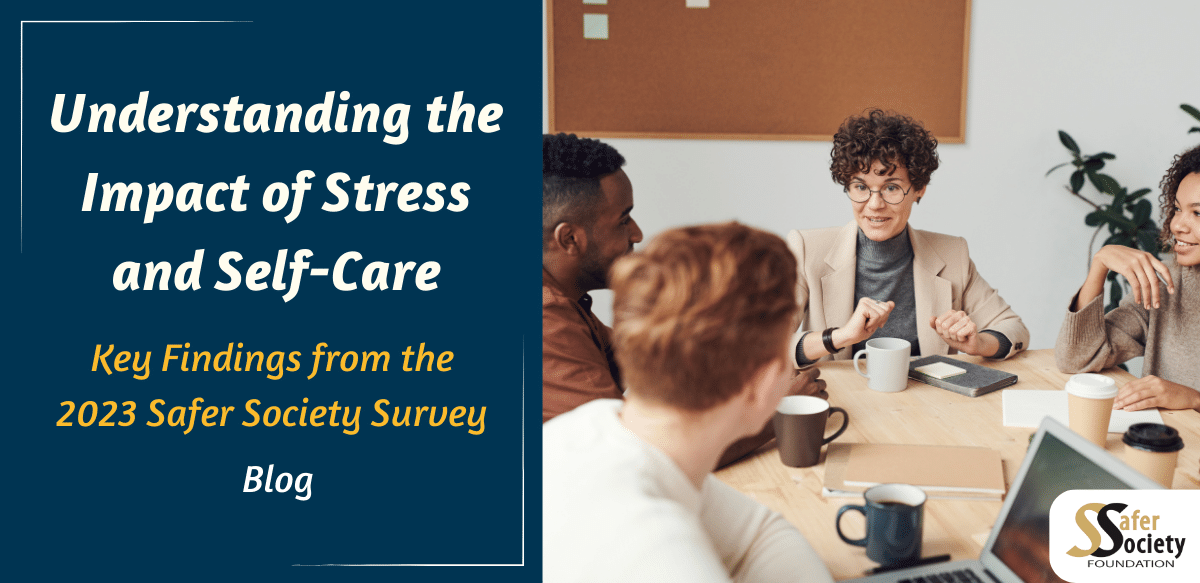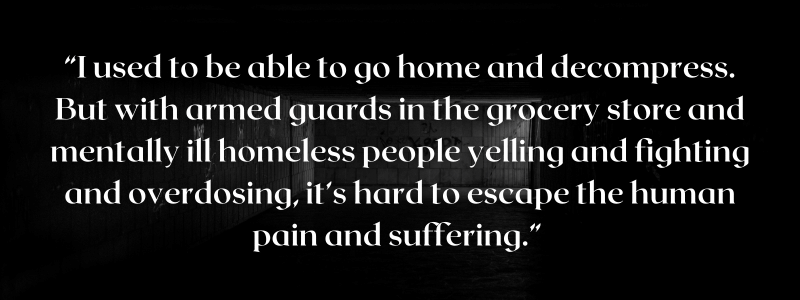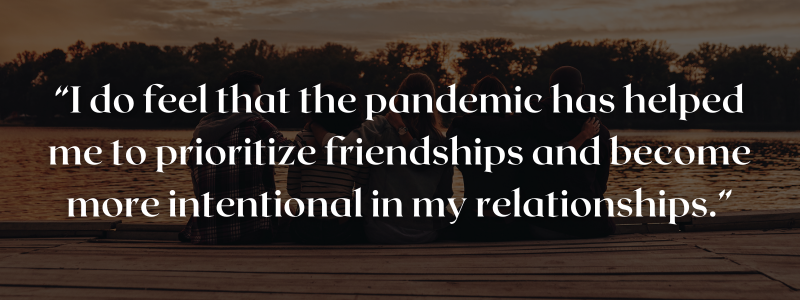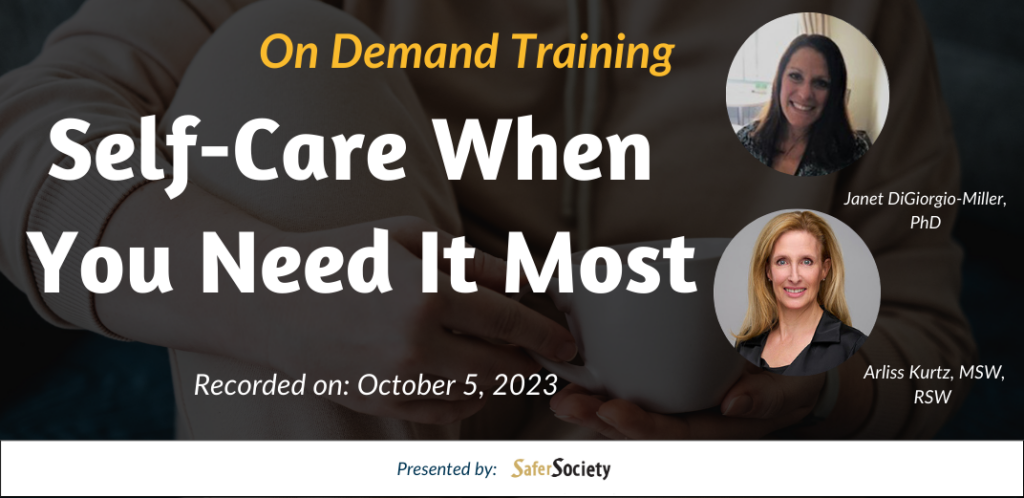
By: David S. Prescott, Janet DiGiorgio-Miller, and Sarah Snow Haskell
The global events of the past few years have significantly impacted people’s lives. We’ve found ourselves figuring our way through the COVID-19 pandemic, increasing effects of climate change, political unrest, civil unrest related to racial and ethnic inequities, increases in food and housing insecurity, and cuts in funding for services to people in the criminal justice system. Now more than ever, it is essential that mental health professionals assess their own mental, emotional, and physical health to ensure the wellbeing of both themselves and their clients.
In the authors’ experience, professionals who work to understand, assess, and treat interpersonal (including sexual) violence can be highly creative and adaptive. Finding constructive ways to address the challenges that this work can present seems to come with the territory. It is not uncommon to hear practitioners talk about self-care strategies as simple as developing a sense of humor and not taking things personally to more deliberate activities, such as visiting with family, spending time in nature, and getting physical exercise. Still, doing this work in the current era is challenging. Participants in support groups and other discussions often talk about the lack of qualified professionals available, challenges with funding, and the “impostor syndrome” that can happen when one feels that workplace demands are outpacing their capacity to perform their duties.
Perhaps for the first time, professionals in the field have been facing many of the same existential concerns as their clients. The COVID-19 pandemic has been one such concern. In acknowledgment of the increased stresses experienced by practitioners in the mental health professions, last year the staff, management, and board of directors of Safer Society Foundation decided that the time had come for us to ask of those in the mental health field we serve, in essence, “How are you doing?”
This blog is a report on what we learned, first by reviewing the survey conducted by ATSA in 2021, then by conducting our own semi-scientific survey of the professionals who read our publications and attend our online trainings. Our survey collected the voices of professionals in the field at the period when the pandemic itself appeared to have ebbed, and yet many of its aftereffects continued to flow. We are grateful to those who contributed so that others will be able to consider how they are doing by comparison.
The April 2021 ATSA Survey

In April 2021, Dr. DiGiorgio-Miller conducted a survey through the listserv of the Association for the Treatment and Prevention of Sexual Abuse (ATSA). The survey involved 244 respondents, all of whom were ATSA members. The data from this survey highlights the significant impact of the pandemic on the mental and physical wellbeing of therapists, particularly among the 20- to 30-year-old age group. The survey findings align with CDC data, which reported an increase in anxiety and depressive disorder symptoms among young adults during the pandemic. The majority of participants felt more uncertain, fearful, and hopeless, with 90% of 20- to 30-year-olds experiencing feelings of isolation. This sense of disconnection was the most significant environmental factor across all age groups.
The physical effects of the pandemic were also evident, with weight changes, difficulty concentrating, and sleep issues reported by various age groups. The survey revealed a decrease in daily and weekly self-care activities and an increase in the number of months spent without any self-care. However, 61- to 70-year-olds engaged in self-care practices 50% of the time before the pandemic and 60% of the time after it began, suggesting that self-care practices may have a positive impact on professional longevity.
During this challenging time, therapists had to provide support to clients for the very issues that they were experiencing themselves, a practice that is typically contraindicated in therapists’ training. However, therapists were called upon to provide client support for not only the impact of the pandemic but also the issues contributing to and resulting from sexual abuse and aggression. The results of this survey emphasized the importance of addressing the mental and physical wellbeing of therapists during the pandemic. It became apparent to many more seasoned clinicians that we needed, first and foremost, to support the newcomers in the field, continue to check in on each other, and find solidarity with each other in the difficult work we do.
The April 2023 Safer Society Survey
In April 2023, David Prescott, Janet DiGiorgio-Miller, and Sarah Snow Haskell conducted a survey of 313 professionals who work in the field of sexual abuse to assess the continued impact the pandemic has had on them, particularly in the last six months. The results of this survey indicated a concerning amount of distress among therapists. The initial findings in the ATSA 2021 survey showed that more than half of the participants (N=244) reported a rise in general stress. Furthermore, the latest survey uncovered that 80% of the respondents experienced symptoms of burnout, indicating the pervasive nature of the issue among the therapists. Unfortunately, it appears that although the pandemic is technically over, stress continues to increase.
The Pandemic’s Lingering Impacts
Stress. In the April 2023 survey, 45% of participants experienced high or very high stress levels in the previous six months. The stress levels were consistent across most age groups, with only slight variations. For instance, 29% of 61-70-year-olds and 43% of those aged 51-60 experienced moderate to high stress levels. The majority of respondents were therapists, and the peak stress level of 48% was observed in those with 21 to 25 years of experience.

Regarding work location, stress levels vary significantly among different types of workers. Specifically, more than half (61%) of remote workers reported experiencing moderate levels of stress. This could be attributed to various factors, such as the blurring of work-life boundaries and the lack of social interaction that is inherent in remote work. On the other hand, 44% of those working in hybrid situations reported moderate stress levels. Hybrid collaboration can be challenging and can lead to communication difficulties and feelings of exclusion among remote participants, potentially contributing to increased stress levels.
In contrast, 41% of in-person workers experienced moderate stress. The lower stress levels among in-person workers could be due to the benefits of more social interaction and a structured workplace environment. However, it’s important to note that in-person work is not suitable for everyone due to various reasons such as health and family circumstances. Furthermore, it’s alarming to note that almost half (45%) of workers across all settings were experiencing high to very high levels of stress.
This data suggests that the pandemic’s impact on stress levels was widespread across different age groups, with experience and work location also playing a role in the stress levels reported by mental health professionals. While the data implies that work location does not significantly mitigate stress levels, it is crucial, especially for supervisors, to embrace more flexible work arrangements, foster supportive environments in the workplace, and provide resources for employees to help manage stress.
Emotional and Social Impact. Several conclusions are drawn from the data regarding the pandemic’s lingering impact on professionals, emotionally and socially. Across all age groups, a significant portion reported feeling more anxious, less socially connected, and more uncertain. Professionals in the 31 to 40 age group reported the highest levels among all three of these impacts. Those in the 20 to 30 age group reported the highest levels of feeling lonely and depressed. Interestingly, professionals in the 51 to 60 age group reported the opposite, feeling more socially connected, hopeful, and calmer.
This data on the emotional and social impacts on professionals reflects diverse responses, highlighting the need for tailored interventions for mental health professionals. The 2023 survey, like the ATSA survey conducted in 2021, indicates that newcomers in the field require support from more experienced clinicians as we seek solidarity with each other in this challenging work.
Consequences of the Pandemic’s Lingering Impacts. The repercussions of mental health professionals experiencing stress, anxiety, and uncertainty can be detrimental to both their personal wellbeing and the quality of care they provide to their clients. Some of the potential consequences include:

- Decreased therapeutic effectiveness: High levels of stress can impair a professional’s ability to provide effective therapy, as they may struggle to maintain focus, empathy, and emotional regulation during sessions.
- Secondary traumatic stress: Mental health professionals may experience secondary traumatic stress, which occurs when they are exposed to their clients’ traumatic experiences and begin to experience symptoms of trauma themselves.
- Compassion fatigue: Stress can contribute to compassion fatigue, a state of physical, emotional, and spiritual exhaustion that can result from prolonged exposure to clients’ suffering.
- Sleep disorders: Stress can lead to sleep disorders, such as insomnia, which can further contribute to the decline in mental and physical health.
- Increased risk of suicide: Stress and mental health concerns can increase the risk of suicide among healthcare workers, particularly when they feel unable to seek help due to stigma or concerns about confidentiality.
Self-Care Strategies
The prevalence of positive self-care practices, such as exercising, spending time outdoors, taking time off, and spending time with friends, family, and pets, was high across different age groups, with 62% of individuals aged 71 to 80 and 51% of those aged 20 to 30 engaging in self-care on a weekly basis. Furthermore, almost three-quarters (74%) of all age groups had a daily self-care practice. However, despite these positive coping practices, 80% of individuals still experienced a high to very high level of burnout.
Respondents were also asked what coping strategies they use that have the potential to be harmful. The prevalence of these strategies varies by age group:
- Binge watching increases with age until the 50s, then decreases.
- Increased eating and working longer hours are highest among those in their 40s and 50s, and lowest among those in their 60s and 70s.
- Increased alcohol use is highest among those in their 20s and 30s, and lowest among those in their 60s and 70s.
- Increased drug use is rare, with only a few respondents in their 30s and 50s reporting this behavior.
The findings suggest that while self-care practices are widespread, not all are equally beneficial for mental health and may not be fully effective in preventing burnout. This highlights the need for a deeper understanding of the relationship between self-care and burnout, especially in high-stress professions. Further research and tailored interventions may be necessary to address the high levels of burnout despite the prevalence of self-care practices.
Respondent Comments
The feedback gathered from the respondents encompassed a wide spectrum of emotions and experiences. Some expressed the profound impact of societal challenges on their mental wellbeing, citing difficulties in finding solace amidst human suffering and the strain of inadequate systemic support, which has been exacerbated by the pandemic. There were also accounts of negative effects on professional dynamics, such as increased negativity and compromised work quality. Additionally, individuals shared concerns about the effectiveness of virtual client interactions and the overall toll of the pandemic on their mental health.

On a more optimistic note, some participants expressed gratitude for the support received and highlighted the positive aspects of their personal and professional lives, including the value of relationships and the opportunity for professional development. This comprehensive range of responses reflects the complex and multifaceted nature of the experiences recounted in the survey.

Discussion
What’s changed? The 2021 and 2023 surveys asked variations of the same basic questions, unearthing a striking continuity in the responses. The pandemic brought anxiety and social disconnection that has lasted for years. Notably, a significant 80% of the 2023 respondents reported experiencing burnout, underscoring the pervasive impact of the pandemic. This finding is in line with broader trends, as evidenced by various studies and surveys within and beyond the helping profession field, reflecting a concerning pattern of burnout across different professions and industries.
It is important to exercise caution in comparing the findings of 2021 and 2023. Neither has been peer-reviewed, and the context of the two surveys differed significantly. The 2021 survey reflects the full impact of the pandemic, while the 2023 survey took place amid a shifting landscape marked by the easing of the pandemic’s worst effects and the emergence of other stressors such as global conflicts, political tensions, and extreme weather events. This evolving backdrop underscores the need to interpret the findings within their respective temporal and contextual frameworks, recognizing the dynamic nature of the challenges faced by professionals in the field.
Clearly, professionals working with individuals who have abused others have experienced high levels of stress, and even the best self-care regimens are rarely enough to completely ameliorate the effects of this stress. It is also clear that the increased stresses and uncertainties of recent years, while changed, have not gone away. It is entirely possible that these results indicated a higher level of stress among the therapists who responded to these surveys compared with those in other studies because these therapists were working under the stresses of the pandemic in addition to their already stressful routine duties with clients who have sexually harmed.
Finally, this survey outlines potential areas for research, such as the fact that in some areas, respondents in their 30s showed less of an increase in some behaviors—such as increased alcohol use and working longer hours—than their older and younger counterparts. At the same time, the experience of stress and anxiety appeared attenuated for older respondents, leading to questions about how professionals may develop resilience with age.
Conclusions
It is concerning that 80% of professionals reported experiencing symptoms of burnout in the last six months, even with most engaging in self-care strategies. Addressing the mental health needs of mental health professionals is crucial to ensure they can provide effective care to their clients and maintain their own wellbeing.
The surveys shed light on the significant impact of the pandemic on the mental and physical wellbeing of therapists, particularly among the 20- to 30-year-old age group. The April 2021 ATSA survey, which involved 244 ATSA members, revealed a decrease in self-care activities and an increase in feelings of uncertainty, fear, and isolation, with the most significant environmental factor being a sense of disconnection. In 2023, the data from the Safer Society survey revealed that the emotional and social impacts on professionals varied, with those aged 31 to 40 experiencing the highest levels of anxiety, social disconnection, and uncertainty. In contrast, professionals aged 51 to 60 reported feeling more hopeful and socially connected, indicating a diverse range of responses.
Despite the prevalence of positive self-care practices, such as exercising and spending time with family, a high level of burnout was still reported, suggesting the need for a deeper understanding of the relationship between self-care and burnout. The feedback from respondents encompassed a wide range of emotions and experiences, reflecting the complex and multifaceted nature of their challenges and coping strategies.

One implication is that organizations and agencies may want to form communities in which professionals can discuss their stresses and self-care without fear of retribution and with the hope of having a positive impact on others as well as oneself. Not only do these findings indicate that we should encourage self-care with others (which is becoming enshrined in the codes of ethics of various professions), but professionals should also check in on one another to encourage a feeling of support and solidarity. Addressing the mental health needs of professionals working with clients who experience trauma and abuse is crucial to ensure they can provide effective care and maintain their own wellbeing.
While the survey does highlight some concerning trends, it also underscores the resilience of professionals in the field, many of whom have made self-care a priority. The integration of enjoyable self-care routines, such as exercise and contemplative practices, into their work lives has been a key strategy for many. Furthermore, the importance of open discussions about well-being cannot be overstated. By fostering an environment where everyone feels comfortable discussing their mental health concerns and self-care practices, we can collectively work towards a healthier future. The authors strongly recommend this approach, emphasizing the need for ongoing dialogue about well-being and future improvements.
Thank you for reading! A free downloadable PDF is available, which includes tables and graphs from the 2023 Safer Society survey.
Self-Care When You Need It Most – On Demand Training
Delve into current research, coping skills, and self-care techniques with survey author Janet DiGirgio-Miller, Ph.D., and co-presenter Arliss Kurtz, MSW, RSW, during this on-demand training hosted by Safer Society Foundation!
The workshop discusses evidence-based self-care techniques to reduce stress, enhance emotion regulation, and promote a sense of calm during distress. The training is designed for professionals in stressful environments and aims to promote daily self-care practices and strategies for both professionals and their clients. The topics covered include recent survey data on the pandemic’s effects, self-care skills, and the link between professional self-care and clients’ wellbeing.
After the training, participants should be better able to understand the pandemic’s impact, assess coping strategies, describe the benefits of mindfulness practices, and explain various self-care techniques.

